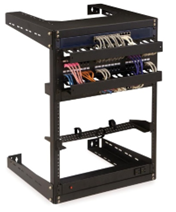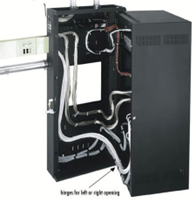Wall Mount Racks and Cabinets: Save Space and Cost
- Jan 12th 2023
- By

While most of us think of free-standing racks and cabinets for housing IT equipment in data centers and telecom rooms (TRs)—MDFs and IDFs—there are plenty of scenarios where a wall mount rack or cabinet is the better option. And like free-standing racks and cabinets, there are many options to choose from. We thought we’d take a look at some common scenarios and environments where wall mount racks and cabinets simply make more sense and key considerations for choosing the right one.
Cost-Effectively Extend Network Connectivity to Remote Locations
Network connectivity today is needed virtually everywhere, including remote spaces that are often located farther than 100 meters from the closest TR. It could be a warehouse or shipping department for a manufacturer, a gymnasium or field house at an educational institution, or a maintenance facility or parking garage for an enterprise business. It could even be a large open space such as a stadium, conference center, or a big box store like Home Depot, Walmart, or Best Buy.
Twisted-pair copper cabling like Category 5e, Category 6, and Category 6A is the primary media for connecting and powering devices such as security cameras, Wi-Fi access points, and access control. However, with cabling distances limited to 100 meters, connecting devices in remote and large open spaces can be challenging. Building out an entirely new telecom room to service a specific location is rarely an option due to limited floor space, cost, and associated power and cooling. Besides, and entire TR is not necessary if you only need to provide a handful of network connections.
Per TIA-568 cabling standards, a TR doesn’t have to be an actual room—it can be just a cabinet. Often referred to as a mini TR, wall mount cabinets are an efficient and cost-effective means to house and protect network switches and patch panels needed to extend service to remote locations or throughout large open spaces. Unlike free-standing cabinets, wall mount cabinets can also be deployed out of reach, which helps keeps equipment secure in public spaces. In fact, wall mount cabinets are ideal for whenever there is a need to distribute network technology out to the edge, including edge computing for low-latency localized processing.
Optimize Space and Secure Fiber Network Equipment
Full-size freestanding racks and cabinets are preferred for housing and protecting substantial amounts of equipment and connectivity in data centers and MDFs. But the reality is that they are often not necessary out in the horizontal space. Wall mount racks and cabinets often provide adequate space for IDFs in a multi-floor network. There are also plenty of environments such as small office/home office deployments that simply don’t have enough equipment to warrant a full-size cabinet and where floor space is at a premium or needs to be kept clear.
Wall mount cabinets are also ideal for housing application-specific equipment that typically does not require a lot of space and often needs to be kept separate and secure. For example, wall mount cabinets and racks are often used for housing audio-visual (AV) equipment and security equipment without taking up value floor space. They are also perfect for housing and segregating equipment that serves a specific space or user, such as for mounting AV equipment in a school auditorium or airline-specific equipment in an airport terminal.
Key Considerations for Selecting Fiber Optic Wall Mount Racks and Cabinets
Just like with a free-standing racks and cabinets, choosing a wall mount rack or  cabinet is first and foremost based on the number of rack spaces, depth, and weight capacity needed to support active equipment, patch panels , PDUs, cable managers , or any other component which will occupy space.
cabinet is first and foremost based on the number of rack spaces, depth, and weight capacity needed to support active equipment, patch panels , PDUs, cable managers , or any other component which will occupy space.
Wall mount racks and cabinets can offer anywhere from 1RU on the small side to as large as 35RU on the large side. Typically, anything 4RU or less in size will be an open rack, but there are low-profile enclosed wall mount cabinets available in just 4RU. The decision to go with an open wall mount rack versus a cabinet often has a lot to do with security and protection—an open wall mount rack is great for mounting equipment within a secure controlled area but not well suited for dusty locations or areas that are open to the public. It’s important to note that wall mount racks and cabinets inherently do not offer the same weight capacities of free-standing racks and cabinets. A 35RU wall mount cabinet typically has a weight capacity of less than 400 lbs., while a 35RU free-standing cabinet can offer capacities upwards of 800 lbs.
With a wall mount rack or cabinet, you also need to consider how the cabinet mounts  to the wall—something you don’t need to worry about with free-standing racks. Swing-out or pivoting wall mount cabinets offer a hinged back frame that allows easy access to the rear of installed equipment for moves, adds, and changes. Fixed flush mount cabinets are better suited for equipment that doesn’t require rear access, but removable side panels can be handy for providing access to cabling. There are even wall mount cabinets designed to mount in the corner of a room , which are perfect for classrooms, offices, or other locations that have limited wall space or where walkways need to remain open.
to the wall—something you don’t need to worry about with free-standing racks. Swing-out or pivoting wall mount cabinets offer a hinged back frame that allows easy access to the rear of installed equipment for moves, adds, and changes. Fixed flush mount cabinets are better suited for equipment that doesn’t require rear access, but removable side panels can be handy for providing access to cabling. There are even wall mount cabinets designed to mount in the corner of a room , which are perfect for classrooms, offices, or other locations that have limited wall space or where walkways need to remain open.
Another consideration for choosing a wall mount rack or cabinet is how the equipment is mounted within the cabinet. Vertical equipment wall cabinets provide a very low profile depth due to vertically mounting of equipment, which can support mounting equipment in very tight spaces. To support different equipment depths, you will also want to look for adjustable rails. Rails with square holes to support cage nuts can also support a wider variety of equipment without worrying about stripping threaded holes.Cage nuts can easily be snapped in and switched out with an inexpensive, easy-to-use cage nut tool . If a cage nut is stripped, you simply remove it and install a new one.
As with any cabinet, you’ll also need to choose a door style—typically either solid, glass, or vented. Solid and glass doors are ideal for keeping out dust and debris, while vented doors offer better air circulation to keep equipment cool. When deploying wall mount cabinets in dusty environments or public spaces such as warehouses, classrooms, transit hubs, and retail spaces, it’s recommended to use a solid or glass door. However, you might need to actively remove heat with cabinet fans.
Save Space & Cost with the Right Wall Mount Rack or Cabinet
Wall mount racks and cabinets offer a cost-effective, space-saving, and secure solution for extending network connectivity, especially in remote or unique environments. Whether you're looking to distribute network equipment to areas beyond the reach of your main telecom room, optimize space for smaller deployments, or securely house fiber optic and network components, choosing the right wall mount cabinet is crucial. By considering factors like rack space, security, airflow, and mounting options, you can ensure that your network equipment is both protected and efficiently deployed. Ready to find the perfect wall mount rack or cabinet for your specific application? Contact us today to discuss your needs and explore our comprehensive range of solutions.
The good news is that Cables Plus offers a comprehensive line of wall mount racks and cabinet to support equipment in a variety of spaces—from the IDF to the edge. Whether you’re looking to distribute the network, save space, and/or secure application-specific equipment, we can help you find the right wall mount rack or cabinet to suit your needs. Just contact us at sales@cablesplususa.com.
